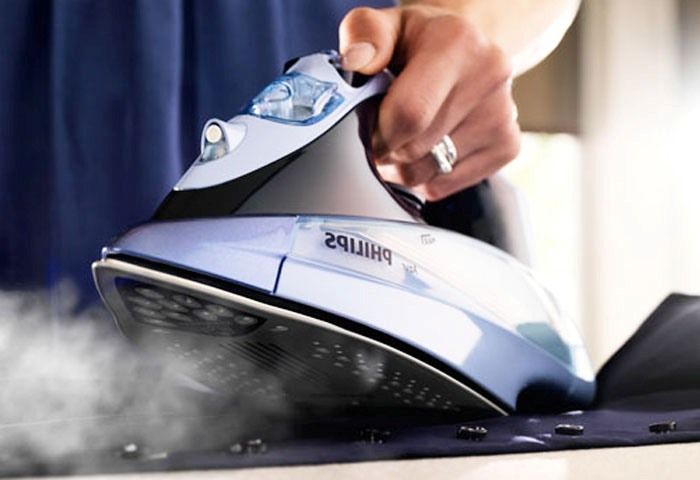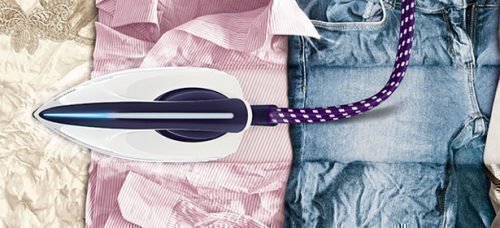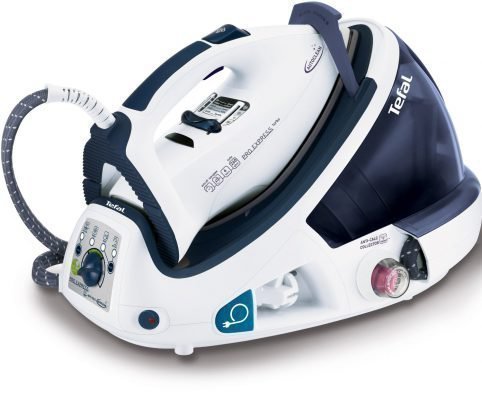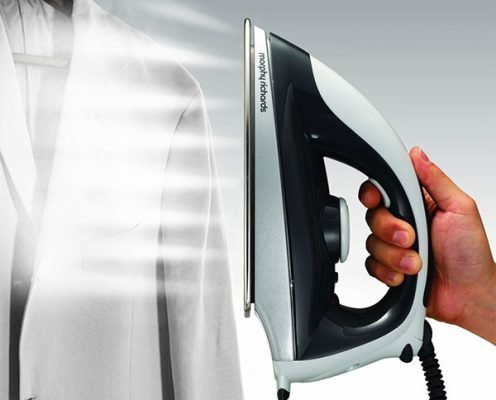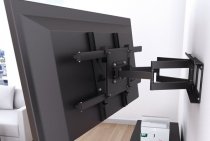How a steam generator works
Before starting work, it is necessary to pour water into the tank: preferably purified, as this will significantly reduce the amount of accruing plaque. It will take about ten minutes to heat the water. Under forcing pressure, steam through the hose enters the iron, through the holes of which it emerges outward to the surface to be treated.
When used correctly, the steam generator is safe. When the steam overheats, the thermostat “turns off” the heating element; if it breaks, this function is transferred to the fuse that opens the circuit (the device is completely turned off). But despite the good protection system, it is better not to leave the steam generator connected to the network unattended.
The principle of operation of the steam generator iron
A steam iron is no ordinary ironing tool. It is a steam station connected to the iron with a flexible hose, through which steam is supplied. The tank into which water is added (both tap and purified water can be used) is called a boiler.
The principle of operation of the iron is simple:
- You add the required amount of water to the water tank and close it.
- Next, select the steam power mode and wait until the water heats up.
- The heated water is converted into steam and fed through a special tube to the soleplate.
- Steam comes out of special holes on the soleplate and smoothes the laundry.
Since an iron with a steam generator is not an ordinary iron, but a steam supply system without additional heating of the soleplate by third-party elements, it does not have additional temperature settings. Most often, in the settings you can find only a steam power regulator, and since you can iron all types of fabrics with steam, it does not need other functions.
The sole of an iron with a steam generator is better to choose ceramic, not metal. The ceramic platform is resistant to abrasion and scratches and is easier to care for.
Iron with a steam generator irons with steam, not heating the sole
Advantages
There are more advantages to using an iron with a steam generator than a conventional iron:
- The weight of the iron is much less than that of a conventional one and, therefore, it is much more convenient to use it.
- Thanks to a special design, steam from the generation department is supplied under a certain pressure. This principle of operation significantly saves your strength, as ironing becomes easier. And the steam pressure regulator allows you to save money by reducing your energy consumption.
- Since the system is equipped with a boiler with a larger volume of water than a conventional iron with a steam function, you do not have to constantly add water to the tank. This will help you iron a large amount of laundry.
- A conventional iron may or may not have a vertical steam function. The steam system always has a vertical steaming function.
- If you're worried that water stains can leave rust stains on expensive clothes, then get a steam generator. Such ironing systems are guaranteed not to leave rust stains on the surface of the fabric and completely eliminate the ingress of large drops of water on clothes during ironing. All heating elements of the system are located inside the boiler and cannot stain the laundry in any way.
- Ironing systems can protect your home from fire. If you accidentally do not turn off the steam generator, then the soleplate of the iron, due to the low temperature, will not be able to ignite the fabric. And the generator itself without movement will turn off and cool down.
Steam iron is convenient and safe
Flaws
In addition to the obvious advantages, steam generation ironing systems have a number of disadvantages:
- Due to similar functions, most consumers confuse ironing systems and irons.But what is suitable for ironing is not suitable for drying. What does it mean? Ironing systems with the function of steam generation allow you to iron things from dense fabrics that are difficult to iron, which, for sure, will be difficult to handle with an iron. But if the question is about how to quickly dry the necessary thing, then ironing systems do not heat the soleplate so much to help you dry the thing. The steam generator is not suitable for such work.
- Some models of steam generators have a long and double hose that is not resistant to twisting and bending. It is quite difficult to use such devices and store them.
- Since the generator has a heating element, it needs constant descaling. Descaling the boiler from scale can sometimes be very difficult, and this must be done regularly and correctly. Therefore, if you do not have enough time for constant cleaning, it makes its use inconvenient.
- Compactness. This is the main disadvantage of any generator model. Not only does it take up a lot of space when ironing, but for proper storage, you will have to give enough space in the house.
- The main drawback of the steam generator is its price. A home steam generator that is used for ironing clothes, as well as a home steam cleaner, will be expensive.
Ironing systems with steam generators are convenient, but quite expensive
Device device
There are three types of steam generators on the market today:
- with a constant supply of water - mainly used in dry cleaners and car washes;
- with low water supply - devices of small size, but also of low power;
- with a boiler - the most common steam stations.
All species are similar in general structure. Their main components are a stainless steel boiler for heating water, a silicone hose with a high melting point, an iron and nozzles. On the body there is a panel with steam supply and temperature regulators.
The boiler itself, in fact, is a combination of a container for liquid (there is also an industrial type, but in a much smaller volume), a heating element, a thermostat and a temperature fuse.
Iron with steam generator
Models come with a built-in generator and stand-alone. For devices with a free-standing steam generator, the supply system is connected using wires and steam hoses.
Device
The product is equipped with a special station with a heating element, a water tank. Hot air flow is supplied through a special hose. The main role here is assigned to the steam station, where heating to the specified values takes place. Its structure is as follows:
- water container;
- heating element (heating element);
- thermostat;
- fuse;
- pressure adjustment switch;
- cover to protect the safety valve;
- valve itself;
- dispenser;
- pressure gauges (in some models).
We list the main elements of the whole structure:
- Back cover - fastened with screws to the case. There is an attachment to the block, in this case the cover is straight. If it is not fixed on the block, then when disassembling the cover, it is necessary to pull it up. The clamps at the same time release the fasteners.
- The block fixes the cable in the housing. Can be monolithic or collapsible. Monolithic is removed by unscrewing the screws on the block and clamp. To remove the collapsible block, you need to squeeze the latches.
- The top cover is fixed with special devices with wringers. Can be removed from both sides.
- The body is screwed to the steam station with recessed fasteners. They differ in shape and length.
- The sole contains conductive and heating elements.
By type, steam stations are distinguished into gravity and pump-action. In the first, the liquid enters where the heating element is located. There, at high degrees, the liquid evaporates. In pump-action water heating is carried out directly in a separate tank.After vaporization, hot air under high pressure is supplied to the sole.
If you need to iron a small amount of laundry and there are no high requirements for the result, gravity-flow products are suitable. If you need to have perfectly ironed things, it is better to use a pump-action model.
Principle of operation
For the correct functioning of the steam station, the following steps must be taken:
- unscrew the valve cover;
- fill the container with water;
- connect the station to the network (voltage 220V);
- turn on the heater button on the panel to start heating the water to 160 degrees.
The principle of operation of an iron with a steam generator is a whole system for supplying hot air without heating the sole. When these values are reached, water turns into steam. Pressure within 0.35 MPa. After 150 seconds the system is ready for operation. The models provide protection against overheating, these functions are provided by a thermostat and a fuse. In the event that the steam mode exceeds the standard values, the automatic shutdown of the heating element is activated. When the degrees drop, the heating automatically turns on. If the thermostat breaks, the fuse ensures safety. If it burns out, the entire circuit is turned off. After replacing the fuse, you can continue using the device.
Wiring diagram
The scheme of an electric iron with a steam generator consists of the following parts:
- euro plugs with grounding;
- relay KM - with winding power circuits;
- SK - position sensor;
- thermostat;
- connecting block;
- thermal protection;
- heating element;
- indicator lamps.
The position sensor with the KM relay performs protection functions. There is also a power indicator LED.
What characteristics you need to pay attention to when choosing a steam generator
It is worth choosing the right steam generator, taking into account not only the appropriate cost or a famous brand. First of all, technology should make life as easy as possible and perform its functions 100%.
The wrong choice can lead to disappointment due to the lack of the expected result, or the user will regret spending money on models with functions that are not needed.
To select the model that suits your needs, you need to evaluate the following characteristics of the device:
- power;
- steam pressure;
- steam supply intensity;
- tank volume;
- heating time;
- iron sole material;
- additional functions.
Power
The power of the steam generator will directly affect its cost, electricity consumption and the heating time of the device. In total, 3 types of power are distinguished:
- 800-1000W;
- 1000-2500W;
- 2500–3100 W.
Steam generators with low power heat up quickly, but cannot cope with difficult areas of fabric and will be poor helpers in everyday tasks. However, if you plan to use it infrequently and only for clothes, you can stop at such models. If the device is planned to be used for cleaning the whole house, power indicators from 1800 to 2500 watts will be optimal. If you need regular use and on many surfaces, you need to choose powerful models.
Steam pressure and intensity of its supply
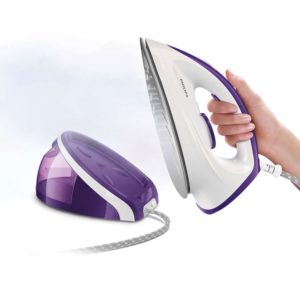
Almost all models are equipped with an interesting indicator - the intensity of the steam supply. Its values show how much steam is produced in 1 minute. The average intensity is considered to be 90-140 grams of steam per minute. Preference should be given to those models that have maximum performance.
In addition to this characteristic, the devices have a steam boost function - it is used in especially dry clothes, hard-to-reach folds.This characteristic can vary between 95-260 grams of steam per minute. It is better to choose higher values.
Tank volume
Each steam generator performs its functions using the main resource - water. Accordingly, if there is a lot of water in the tank, more functions can be performed without interruption and waiting for reheating. However, a large tank will make the device bulky, non-mobile and heavy. Volume indicators can be from 400 ml to 2.2 liters. If you plan to use the technique rarely and for a small amount of clothes, a tank with a volume of 400 ml is also suitable. In the case when steaming is necessary for a family of several people, cleaning in the house - of course, large volumes of water are needed.
Heating time
This indicator will provide fast and convenient work with a large amount of material. Different models may need 2 to 10 minutes to heat up
With rare use of the steam generator, you can ignore these figures, but it is still more convenient to work with units where this figure is 3-4 minutes
Iron head material
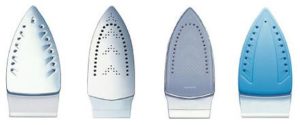
- the aluminum sole is inexpensive, heats up quickly, but can leave white marks on clothes;
- titanium soles are of high quality, expensive and not capable of ruining clothes, but heavy;
- the combined sole includes an aluminum base and a Teflon or ceramic coating, which do not leave shine on the fabric and do not weigh down the sole.
Additional functions
Considering that steam generators are universal devices, the presence of additional functions in them is desirable. The main ones are:
- protection against scale;
- vertical steam function;
- dry ironing;
- the possibility of splashing;
- auto-off mode;
- anti-drip system.
These functions cannot be called insignificant. It is their presence in combination with the current characteristics that will allow you to purchase the model that will benefit and make life easier.
How various functions work
Manufacturers offer various functions of electric irons to ensure the convenience of ironing. We list the main ones:
- automatic shutdown and thermostat;
- steam supply;
- work without a regulator;
- system against the formation of drops;
- steaming in a vertical position.
Let's consider each type separately.
Automatic shutdown and thermostat
Turning off the iron in automatic mode is necessary for fire safety purposes. The design contains a heating element. To prevent fire, the fuse shuts down the system if it is:
- 30 seconds in a horizontal position without use;
- about 10 minutes without moving vertically.
The specified parameters are accepted as a safety standard. The basic principle of operation of the thermostat is the selection of the required ironing mode for different types of fabrics. This is a switch that, when turned, selects the heating set point. Upon reaching it, the thermostat opens the circuit, the current supply stops. After a few minutes, the process resumes, heating continues.
Steam supply
The steam supply is controlled by two buttons. The first carries out the flow of steam through the holes in the sole. When pressed, a portion of water heats up, turns into steam, which is supplied to the base. If you press the second button, water flows to the spout and is sprayed over the fabric. The function is convenient when processing heavily wrinkled clothes or linen and helps to carefully smooth out all the wrinkles. Some models have a steam boost function (enhanced steam jet), which helps to process thick fabrics with folds.
If untreated tap water is used, this leads to the formation of limescale on the surface of the heating elements. Water that is harder in its composition reduces the effect of heating faster and can lead to failure of heating elements. It is necessary to monitor the appearance of rust spots, scale particles when using a household appliance. Timely cleaning of the heating elements will extend the service life.
In expensive equipment, there is a filtration system that provides the supply of already purified water. The unit of measure for steam supply is grams per minute. The average continuous feed rate is 10-150 grams / minute. If the fabric is not overdried before ironing, 30 grams per 1 minute is enough.
Operation without regulator
In some models, the function of a household appliance with steam without regulation of degrees and steam supply is applied. Manufacturers offer users to iron different types of fabrics (silk, cotton, linen, wool, etc.) without thinking about switching ironing modes. Such models are suitable for thin fabrics where there is no need for high values of the heating element. For dense products, models without temperature control are best not to use.
Anti-drip system
During vaporization, there is a possibility of water droplets flowing out of the holes on the sole. The reason for this is inertia - the product must heat up in order to dial the desired mode. If not all the liquid has been used during ironing, the anti-drip system will not allow the remaining water to flow out of the container after turning off. When the household appliance is connected to the network, it prevents extra drops on the fabric.
Steaming in a vertical position
It is very convenient to process things with hot steam without removing them from the hanger in an upright position. Note that there is no contact between the sole and the fabric during this process. This function is used to smooth out fabrics that cannot be ironed by direct contact with the heating element.
You need to select the appropriate model according to the characteristics, taking into account the following rules:
- product cord up to 2 meters, braided, preferably on a rotating hinge;
- you should purchase a household appliance with a large temperature setting;
- the optimal weight is from 1.5 kg, it will be more difficult to smooth the fabric with a lighter one.
What model of iron to choose for use in everyday life? We tried to answer this question by considering the basic principles of operation and the design of the main modifications.
Steam generator steam station, iron with steam generator

Unlike irons, the steam generator is equipped with a remote boiler for generating steam, connected to the iron via a flexible hose. By separating the two components, the device was able to reduce weight and increase the volume of steam. It is called differently: an iron with a steam generator, a steam station, but it's all the same. It is worth considering that some people under the steam generator mean an iron with steam, although we think this is not correct.
Why is a steam station good?
- In addition to standard things, it is suitable for ironing coarse and dense fabrics.
- The high temperature mode and continuous steam supply allows you to iron even complex folds and creases in linen.
- In addition, using this mode, you can significantly reduce the ironing time due to the ability to smooth out large fabrics (bedding, tablecloth, curtains, towels), folding them in several layers at once.
- With the vertical steam function, you can straighten already worn items or, for example, hanging curtains.
- Some models of steam generators are equipped as standard with additional nozzles that allow you to clean the upholstery of upholstered furniture and remove unpleasant odors from things using the steam cleaner mode.
Cons of the device
Based on the reviews of people on the Internet, we can make an unambiguous conclusion - there are only two minuses: the high price of this device and its bulkiness.Otherwise, the steam generator significantly outperforms the devices we are used to.
What to look for when choosing
- Device power.
- Water vapor pressure. You should not purchase a steam station that does not produce an outlet pressure of more than 3 bar;
- Tank volume. The main parameters of the devices on the market range from 0.5 liters to 4;
- Sole material. Here choose as in the case of an iron. The best option is Teflon, the worst is aluminum.
- Additional functions. At your discretion, any additional function may come in handy. But the price of steam stations also depends on their availability.
Advantages
The steam generator has a number of advantages over both the iron and its close relative - the steamer.
It allows you to smooth complex folded products without leaving any traces of creases. Thanks to the powerful steam jet, you can also iron multiple folded items (for example, bed linen), which will significantly speed up the process.
The low humidity of steam (about 6%) makes it possible to use it for steaming any fabrics, including delicate ones.
What distinguishes an iron with a steam station from a steamer is the ability to use it at any angle, which globally expands the area of its application: from ironing curtains to treating floor surfaces and cleaning a car.

The main disadvantages of a steam generator are usually large dimensions (compared to an iron) and high cost, however, this is a moot point, since one device can replace several at once, thanks to its wide range of functions.
The steam generator is a device that is similar in functionality to the steam generator of a household iron. Its principle of operation is to heat water to a vapor state and then release the steam into the air. This is a universal device suitable for both domestic purposes and for production. Let's see what types of steam generators exist, for what purposes they are used, and how to use a steam generator correctly.
A steam iron is sometimes called a steam generator.
So, let's start with the simplest and most well-known device: a steam iron. Despite such a big name, at its core it is an ordinary iron with the ability to turn on the steaming mode. This design has been known to everyone for a long time. Of course, irons of this kind have undergone some changes both in design and functionality, but as they were tools of manual labor, they remained so.
What is good steam iron
One of the advantages of a steam iron is a huge selection of models, both in design and price group.
Another plus is the portability of this device. Anywhere, anytime, you can iron or steam things. By purchasing a small-sized iron model, you can take it on trips.
The versatility of the device. Sometimes the hostess has to deal with things that are difficult to iron (smoothed folds, overdried linen, thick fabric) - here the steaming effect will come to the rescue. The ironing process is made much easier thanks to the possibility of steam boost and moisturizing.
Cons of the device
- Surprisingly, all the same versatility. Due to the fact that both a water tank and heating elements have to be installed in one device, the design turns out to be bulky, heavy and loses some useful functions (in particular, vertical steaming, although some models still have it).
- Another disadvantage is the need to use an ironing board in the process.
- The contact of the hot sole with the material increases the chance of ruining your favorite item.
- It is not possible to iron things with decorative elements (rhinestones, bows, lace).
- Small water tank. As a result - a short period of work between the filling of liquid.
What to look for when choosing
- Sole material.Professionals advise buying devices with Teflon coatings. They are smoother, resistant to damage and burning.
- Device power. A good iron cannot have a power of less than 1300W.
- Number of operating modes. The more of them, the better.
- The volume of the water tank. The larger it is, the fewer fluid topping cycles are needed. However, this factor affects both the weight of the iron and its dimensions.
- Scale protection. If this parameter is present, then any water can be poured into the iron, even from the tap. If it is not available, you will have to use only distilled.
- Anti-drip system. This function allows you to reduce the amount of condensation on the soleplate of the iron, which will prevent unnecessary wetting of things.
Instead of an iron, you can use a steam station or a steamer, it will not be easy to choose between them, since each device is good in its own way.
